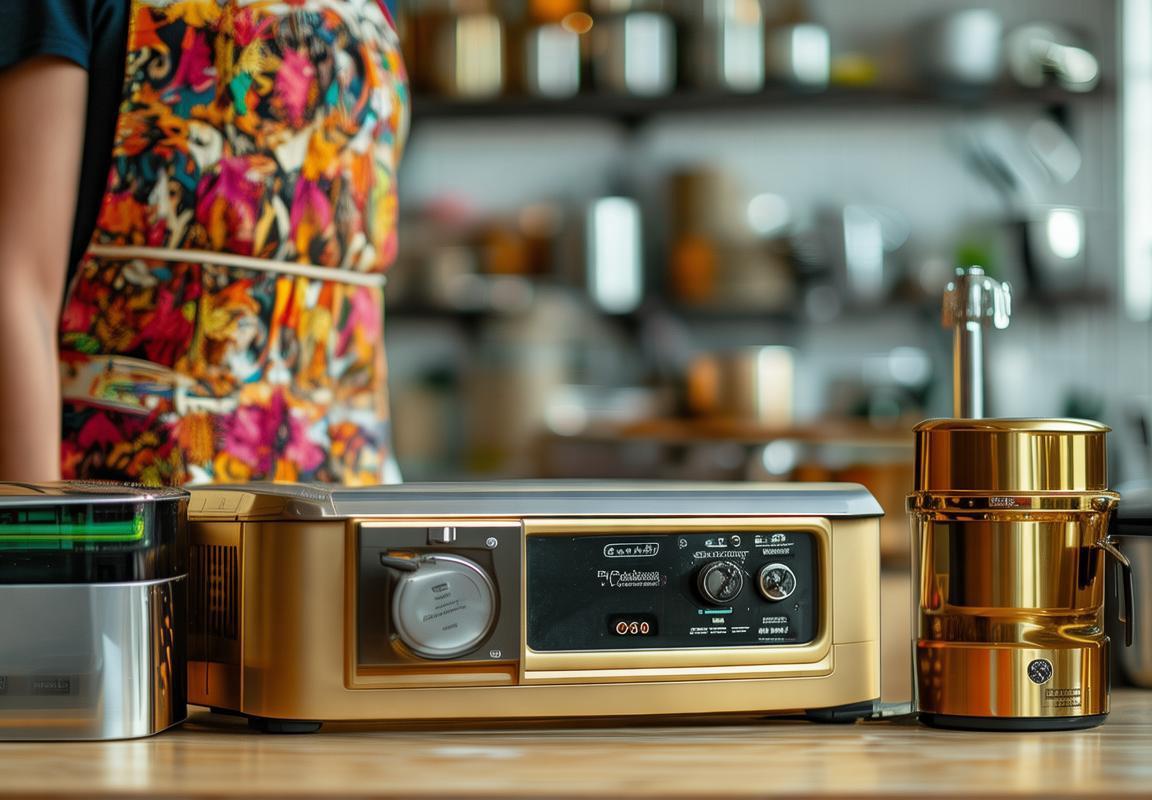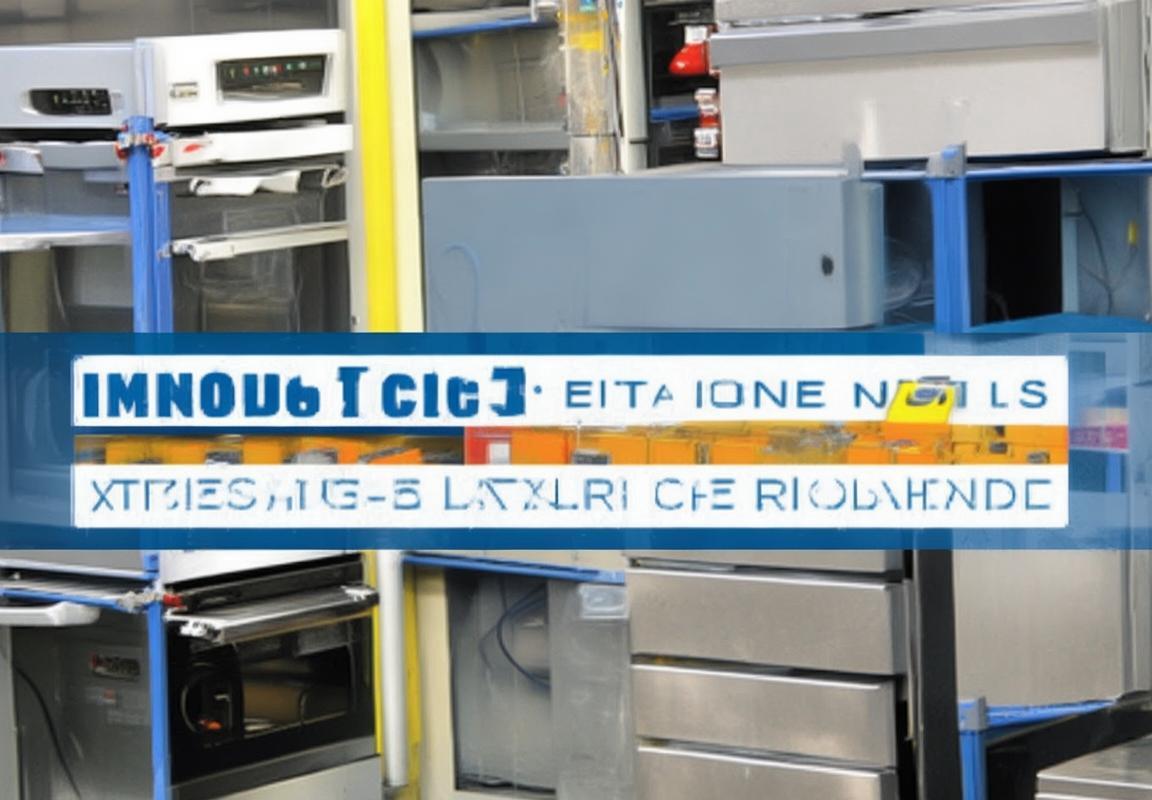In an era where global trade shapes the landscape of many industries, the kitchen appliances sector is no exception. The shift towards import substitution has become a pivotal strategy for suppliers looking to carve out a niche in the competitive Western markets. This trend, marked by a resurgence in domestic production and a preference for locally sourced goods, has profound implications for both manufacturers and consumers alike. By examining the factors driving this shift, we can gain a deeper understanding of the dynamic changes occurring within the kitchen appliances industry.
Understanding the Importance of Import Substitution Programs in Kitchen Appliances
Import substitution programs have emerged as a pivotal strategy in the kitchen appliances industry, particularly in the Western markets. These initiatives are designed to reduce dependence on imported goods by fostering domestic production and supply chains. Understanding the significance of such programs is crucial for both manufacturers and consumers alike, as they can have far-reaching effects on the market landscape, pricing, and innovation.
At the heart of import substitution lies the idea of supporting local economies and industries. By prioritizing domestic production over foreign imports, these programs aim to create jobs, stimulate economic growth, and strengthen national self-sufficiency. In the context of kitchen appliances, this means that manufacturers and suppliers must adapt to the demands of producing high-quality, cost-effective products that can compete with international brands.
One of the key benefits of import substitution programs is the potential for cost savings. When a country relies heavily on imported kitchen appliances, it can face fluctuating exchange rates and supply chain disruptions that can drive up prices. By investing in local production, governments and companies can mitigate these risks and offer consumers more stable pricing. This can be particularly important in regions where budget-friendly appliances are a necessity for many households.
Moreover, import substitution programs can lead to a more diverse and robust market. Local manufacturers often cater to specific regional preferences and needs, which can result in a wider variety of products. This diversity not only benefits consumers by providing more choices but also encourages innovation as companies compete to offer unique features and designs.
In Europe, the kitchen appliances market has seen a significant shift towards import substitution in recent years. This is partly due to the region’s strong emphasis on sustainability and the desire to reduce its carbon footprint. By producing appliances locally, European manufacturers can reduce transportation-related emissions and align with the continent’s green initiatives.
Data from the European Union shows that the number of domestic kitchen appliance manufacturers has been growing, with many companies investing in advanced production technologies and sustainable materials. This trend is not only beneficial for the environment but also for the local economy, as these investments create jobs and attract foreign direct investment.
Similarly, in the United States, import substitution programs are gaining traction, driven by a combination of economic and political factors. The US government has been encouraging domestic production to ensure national security and reduce trade deficits. This has led to a surge in the number of suppliers and manufacturers that are focused on producing kitchen appliances domestically.
The impact of import substitution on the US market is evident in the rise of “Made in USA” labels on kitchen appliances. Consumers are increasingly seeking out locally produced goods, not only for quality assurance but also for the sense of pride and support for the local community. Suppliers that can capitalize on this trend by offering appliances that meet both quality and patriotic demands are likely to see a boost in sales.
However, the path to successful import substitution is not without its challenges. For suppliers, the transition from importing to producing domestically can be complex. It requires significant investment in new facilities, technology, and skilled labor. Moreover, there is the risk of higher initial costs, which can make locally produced appliances less competitive in the short term.
For governments, implementing import substitution programs involves careful planning and coordination. Policies must be designed to incentivize domestic production without causing harm to other sectors of the economy. This includes providing subsidies, tax breaks, and other forms of support to manufacturers.
In conclusion, import substitution programs in the kitchen appliances industry are a multifaceted strategy with the potential to reshape the market landscape. By promoting local production, these programs can lead to lower costs, greater diversity, and a more sustainable future. For suppliers, understanding the nuances of these programs and adapting their strategies accordingly is key to capitalizing on the opportunities that lie ahead.

The Growing Demand for Local Suppliers in the Western Appliance Market
The Western appliance market has undergone a significant transformation in recent years, with a marked increase in the demand for local suppliers. This shift is not merely a trend but a strategic response to various factors that are reshaping the industry.
Consumers in Western countries, particularly in Europe and the United States, are increasingly valuing the local aspect of products. This preference is driven by a desire for better quality control, shorter supply chains, and a sense of community. Local suppliers offer appliances that are more attuned to the specific needs and preferences of the local market.
One of the key drivers behind this growing demand is the concern over environmental sustainability. Local suppliers often have a smaller carbon footprint compared to international manufacturers, as they source materials and produce appliances closer to the end consumer. This has become a significant factor for eco-conscious consumers who are willing to pay a premium for products that align with their environmental values.
Additionally, the rise of the “buy local” movement has bolstered the appeal of local suppliers. People are becoming more aware of the economic and social benefits that come with supporting local businesses. When appliances are sourced from nearby, it creates jobs within the community, strengthens the local economy, and fosters a sense of pride among residents.
The global supply chain disruptions, particularly those highlighted by the COVID-19 pandemic, have also accelerated the trend towards local suppliers. The unpredictability and delays in international shipping have made domestic suppliers more reliable and less susceptible to external shocks. This reliability is crucial for the retail sector, which needs to ensure a steady supply of appliances to meet consumer demand.
Innovation and customization are other aspects where local suppliers have an edge. They can often respond quickly to market changes and consumer feedback, leading to the development of appliances that are tailored to specific regional tastes and usage patterns. This agility allows them to introduce new products and features that resonate well with local consumers.
The rise of e-commerce has also played a role in this shift. Online platforms have made it easier for local suppliers to reach a broader audience, including international buyers. This has expanded the market for local appliances beyond just domestic consumers, opening up new opportunities for growth.
Furthermore, local suppliers often have a deeper understanding of the regulatory environment in their regions. They are more likely to comply with local standards and certifications, which can be a critical factor for consumers looking for appliances that meet specific safety and performance requirements.
Despite the growing demand, local suppliers in the Western appliance market still face challenges. They must compete with established international brands that have a strong global presence and brand recognition. To succeed, local suppliers need to focus on building a strong brand identity that resonates with consumers and differentiates them from their competitors.
Moreover, scaling up operations to meet the demands of a larger market can be a daunting task for local suppliers. They must invest in technology, production capacity, and distribution networks to ensure they can meet increasing orders without compromising on quality.
In conclusion, the demand for local suppliers in the Western appliance market is on the rise, driven by a variety of factors including consumer preferences, environmental concerns, and the need for reliable supply chains. As the market continues to evolve, local suppliers will need to leverage their unique advantages and address the challenges that come with expanding their operations to capitalize on this growing trend.

The Role of Import Substitution in Shaping the European Kitchen Appliances Landscape
The European kitchen appliances landscape has undergone a significant transformation, largely influenced by the rise of import substitution programs. These initiatives have played a pivotal role in reshaping the market dynamics, fostering local production, and promoting sustainability. Here’s a closer look at how import substitution has impacted the European kitchen appliances sector.
Manufacturers in Europe have increasingly turned to domestic suppliers to meet the growing demand for kitchen appliances. This shift is a direct response to the challenges posed by international trade and the need to reduce dependency on imports. The European Union’s commitment to promoting local production has led to a surge in support for domestic suppliers, creating a more robust and self-sufficient market.
The rise of import substitution has been particularly pronounced in countries like Germany, Italy, and France, where traditional craftsmanship and high-quality materials are a hallmark of the kitchen appliances industry. These nations have leveraged their strong manufacturing bases to develop innovative products that cater to both domestic and international markets, enhancing their competitive edge.
One of the key benefits of import substitution in the European kitchen appliances market is the creation of jobs. By encouraging local production, these programs have helped to sustain employment in manufacturing sectors, contributing to economic stability and growth. The ripple effect of this has been a boost in the overall standard of living, as more Europeans can afford high-quality appliances made within their own borders.
Environmental concerns have also played a significant role in the push for import substitution. European consumers are increasingly aware of the environmental impact of importing goods from distant countries. By focusing on domestic production, manufacturers can reduce carbon footprints, minimize energy consumption, and adopt greener manufacturing practices. This shift towards sustainability has resonated with consumers, who are more likely to purchase appliances that align with their eco-friendly values.
The European kitchen appliances market has seen a surge in innovation as a result of import substitution. Local manufacturers are now free to invest in research and development without the constraints of competing with global giants. This has led to the creation of unique products that not only meet European standards but also address specific regional needs. For instance, appliances designed for colder climates or those that cater to the Mediterranean lifestyle have gained popularity.
Import substitution has also encouraged collaboration between European countries. Cross-border partnerships have become more common, as manufacturers seek to share resources and expertise to enhance their production capabilities. This has resulted in a more integrated and competitive European market, where companies can leverage the strengths of their neighbors to offer a wider range of products.
Despite the benefits, the transition to import substitution has not been without its challenges. Some European manufacturers have struggled to compete with cheaper imports, leading to job losses and the closure of factories. However, the long-term vision of creating a self-sustaining market has prompted governments and industry leaders to invest in retraining programs and infrastructure improvements to support the domestic appliance industry.
Consumer preferences have also evolved in response to import substitution. There’s a growing trend towards buying locally-made products, driven by a sense of pride and the desire for quality assurance. This shift has prompted manufacturers to focus on design, functionality, and customer service, ensuring that their products not only meet but exceed consumer expectations.
The European kitchen appliances market is now a testament to the power of import substitution. It has become a beacon of sustainability, innovation, and economic resilience. The landscape is characterized by a diverse range of products that cater to a variety of needs, all supported by a strong foundation of local manufacturing. As the market continues to evolve, it’s clear that import substitution will remain a crucial factor in shaping the future of European kitchen appliances.

Key Trends in the US Kitchen Appliances Industry
The US kitchen appliances industry has witnessed a surge in innovation and consumer preferences, leading to several key trends that are reshaping the market. From smart technology integration to sustainability concerns, here’s a closer look at the trends that are driving this sector forward.
Smart Home Integration is on the RiseConsumers are increasingly looking for appliances that can be controlled remotely or integrated into a larger smart home ecosystem. Smart refrigerators, ovens, and dishwashers are becoming more common, offering features like Wi-Fi connectivity, voice control, and predictive maintenance to enhance convenience and efficiency.
Energy Efficiency and SustainabilityWith growing environmental consciousness, there’s a significant push towards energy-efficient appliances. The US market is seeing a rise in Energy Star-rated products that consume less energy and have a lower environmental impact. Brands are also focusing on sustainable materials and manufacturing processes to reduce their carbon footprint.
The Demand for CustomizationToday’s consumers are looking for appliances that cater to their unique needs and preferences. Customizable appliances, such as refrigerators with adjustable shelves or dishwashers with different wash cycle options, are becoming more popular. This trend reflects a shift from mass-produced, one-size-fits-all products to personalized solutions.
Health and Wellness FeaturesAppliances with health and wellness features are gaining traction. For example, smart ovens that can monitor and adjust cooking temperatures to ensure food is cooked safely and to perfection. Additionally, water filtration systems and air purifiers built into kitchen appliances are becoming standard, as consumers prioritize clean and safe living environments.
Increased Focus on Smart Cooking TechnologyCooking technology has seen significant advancements, with appliances like induction cooktops and pressure cookers becoming more popular. These technologies offer precise temperature control and faster cooking times, making them attractive to busy families and individuals looking to save time and energy.
The Shift Towards Smaller, Compact AppliancesAs urban living becomes more prevalent, there’s a growing demand for compact kitchen appliances. These smaller, space-saving units are perfect for apartments and smaller homes, and they often come with the same features as their larger counterparts.
Rising Popularity of Smart Fridge FeaturesSmart refrigerators are not just about keeping food cold; they’re becoming a hub for various functionalities. From tracking food expiration dates to ordering groceries online, these refrigerators are equipped with technology that not only makes life easier but also healthier.
The Influence of Social Media and Online ReviewsSocial media and online reviews play a crucial role in shaping consumer preferences in the kitchen appliances industry. With the ease of sharing experiences and recommendations, brands are paying closer attention to their online presence and customer feedback.
The Importance of Connectivity and Data AnalysisAppliance manufacturers are leveraging data analytics to improve product performance and user experience. By collecting data on usage patterns, they can offer personalized maintenance tips, energy-saving suggestions, and even predictive maintenance alerts.
The Growth of Modular Kitchen AppliancesModular kitchen appliances allow for greater flexibility and customization. Consumers can choose components that best fit their kitchen layout and needs, creating a more personalized and efficient kitchen space.
The Emergence of Eco-Friendly MaterialsBrands are exploring eco-friendly materials for their kitchen appliances, not just for sustainability reasons but also for durability and aesthetics. Recycled materials and sustainable sources are becoming more common, appealing to environmentally conscious consumers.
As the US kitchen appliances industry continues to evolve, these trends highlight a focus on innovation, personalization, and sustainability. Manufacturers that can adapt to these changing consumer demands will be well-positioned to thrive in this dynamic market.

Data-Driven Insights: The Impact of Import Substitution on Market Share
In the evolving landscape of the kitchen appliances market, the impact of import substitution is becoming increasingly evident. This strategic approach, which focuses on reducing reliance on foreign imports by fostering domestic production, has several profound effects on market share dynamics. Here’s a closer look at the data-driven insights revealing this impact:
Manufacturers are reallocating resources. With the rise of import substitution, companies are investing more in domestic production facilities and supply chains. This shift is reflected in the financial reports, showing a significant increase in capital expenditure on equipment and technology to boost local manufacturing capabilities. The result is a more robust local market, with products that are increasingly competitive in quality and innovation.
Consumer preference is shifting. Market research indicates a growing preference among European consumers for locally produced appliances. This trend is bolstered by the perceived quality and the “local first” sentiment, especially post-pandemic. Data from consumer surveys reveal a notable rise in the willingness to pay a premium for products that are made within the region, contributing to a rise in market share for domestic suppliers.
Export markets are benefiting. As domestic manufacturers strengthen their production capabilities, they are not only capturing a larger domestic market share but also expanding their reach into international markets. This dual strategy has been successful for several European appliance brands, as they leverage their new production efficiencies to penetrate new geographies, thereby increasing their global market share.
Economic policies are playing a pivotal role. The implementation of import substitution programs is often driven by government policies aimed at protecting local industries and fostering economic growth. These policies, such as tariffs and subsidies, directly influence market share by making foreign products less competitive. Data from the European Union and individual member states show a correlation between such policies and the rise of domestic brands in the market.
Innovation is on the rise. The push to develop domestic production capabilities has spurred innovation within the industry. Local manufacturers are investing in research and development to create products that are not only in line with global standards but also tailored to local preferences. This innovation is evident in the variety and sophistication of new kitchen appliances hitting the market, further enhancing the appeal of domestic brands.
Environmental concerns are driving market share. A significant shift in consumer and regulatory focus towards sustainability has given domestic manufacturers an edge. Appliances that are energy-efficient and eco-friendly are more likely to be produced locally, as European governments have set stringent environmental standards. The data reflects a higher market share for such appliances, as consumers prioritize green technology in their purchasing decisions.
Competitive pricing is gaining traction. Import substitution often leads to a more competitive pricing landscape, as domestic manufacturers strive to capture a larger share of the market. The cost advantages of producing locally, combined with the elimination of import duties, have allowed many European brands to offer competitive pricing without compromising on quality. This competitive edge is a crucial factor in the increase of their market share.
The rise of online sales channels. With the increasing penetration of e-commerce in Europe, domestic suppliers are capitalizing on online sales to expand their market reach. Data from e-commerce platforms shows a substantial growth in online kitchen appliance sales, with domestic brands leading the charge. This digital transformation is another factor contributing to the rise in market share for local suppliers.
Overall, the impact of import substitution on market share is multifaceted, with a variety of factors influencing the success of domestic kitchen appliance brands. From policy support to consumer preferences and the rise of e-commerce, the data-driven insights paint a clear picture of a market that is increasingly favorable to local suppliers.

Strategies for Suppliers to Capitalize on Import Substitution Trends
Understanding the nuances of import substitution trends is crucial for suppliers looking to capitalize on this dynamic shift in the market. Here’s how they can navigate and leverage these trends effectively:
In the wake of import substitution, suppliers are increasingly focusing on developing local manufacturing capabilities. This shift not only reduces dependency on international suppliers but also fosters innovation and growth within the domestic industry.
To thrive in this new landscape, suppliers must prioritize quality assurance. As local appliances become the norm, consumers are likely to demand higher standards of craftsmanship and performance. Suppliers need to invest in advanced production techniques and quality control measures to meet these expectations.
Collaboration with local research and development (R&D) entities is another key strategy. By partnering with universities, research institutions, and tech startups, suppliers can stay ahead of the curve in terms of technology and design. This can lead to the creation of unique products that appeal to a discerning market.
Efficient supply chain management is paramount. With the rise of local production, suppliers must ensure a streamlined process from raw materials to finished goods. This includes establishing reliable partnerships with local suppliers and optimizing logistics to minimize costs and delivery times.
Marketing and branding play a pivotal role in the success of local suppliers. As they compete with established international brands, suppliers need to craft compelling narratives that highlight the benefits of locally made products, such as support for the local economy and environmental sustainability.
Investing in workforce development is essential. Suppliers should focus on training their employees to be adaptable and skilled in the latest manufacturing technologies. This not only enhances productivity but also reduces the risk of workforce shortages that could impact production schedules.
Embracing digital transformation is non-negotiable. Suppliers should leverage data analytics and automation to improve operational efficiency. This can lead to cost savings and enable suppliers to scale up production as demand grows.
Local suppliers should also explore export opportunities. As they gain a strong foothold in their domestic markets, they can look to expand their reach internationally. This requires understanding different market dynamics and adapting their products to meet international standards and regulations.
Collaborating with distributors and retailers is critical. Establishing strong relationships with local channels can help suppliers ensure their products are readily available to consumers. This also allows for valuable feedback that can inform product development and marketing strategies.
Participation in trade shows and industry events can significantly boost a supplier’s visibility. These platforms provide opportunities to showcase products, network with potential customers, and stay informed about industry trends.
Finally, suppliers must be prepared for regulatory changes. Import substitution programs often come with new regulations that can impact production, import, and export processes. Staying abreast of these changes and being proactive in compliance can help suppliers avoid costly penalties and maintain their competitive edge.
By focusing on these strategies, suppliers can effectively capitalize on the trends of import substitution and secure a robust position in the evolving kitchen appliances market.

Case Studies: Successful Import Substitution Programs in Europe and the US
In Europe, the import substitution trend has been a significant driver for local kitchen appliance manufacturers. One notable case is the success story of Electrolux in Sweden. Once a dominant player in the global market, Electrolux faced stiff competition from Asian suppliers. To counter this, the company shifted its focus to developing innovative and high-quality appliances that catered to the European market’s specific needs. This strategic pivot allowed Electrolux to regain market share and strengthen its position in Europe.
In the United States, General Electric (GE) Appliances is another example of a company that has thrived through import substitution. Recognizing the potential of the domestic market, GE Appliances invested heavily in R&D to create energy-efficient and smart kitchen appliances. By focusing on American consumers’ preferences and leveraging local manufacturing capabilities, GE Appliances managed to capture a significant portion of the U.S. market, reducing the reliance on imports.
In Europe, the Italian kitchen appliance manufacturer, SMEG, has also made a name for itself through its import substitution strategy. SMEG’s products are known for their retro design and high-quality craftsmanship, which resonate well with European consumers. By emphasizing local production and traditional values, SMEG has been able to maintain a strong market presence in Europe, even as international competition intensified.
On the other side of the Atlantic, Whirlpool Corporation has successfully implemented import substitution in the U.S. market. By acquiring Maytag and KitchenAid, Whirlpool expanded its product range and production capabilities, allowing it to meet the growing demand for domestic appliances. The company has also invested in energy-efficient and smart kitchen appliances, which have helped it maintain its market leadership in the U.S.
In the UK, the company Hotpoint has taken a different approach to import substitution. By focusing on sustainability and eco-friendly appliances, Hotpoint has gained a loyal customer base. The brand’s commitment to reducing its carbon footprint has resonated with environmentally conscious consumers, helping Hotpoint to carve out a niche in the UK market.
These case studies highlight the various strategies that companies have employed to succeed in the import substitution landscape. From focusing on local production and craftsmanship to investing in innovation and sustainability, these companies have managed to maintain their market share and grow their businesses despite the challenges posed by international competition.
Electrolux’s success in Europe can be attributed to its ability to adapt to the market’s changing dynamics. By understanding the unique needs and preferences of European consumers, the company was able to develop products that stood out from the competition. This customer-centric approach has allowed Electrolux to maintain its position as a leader in the European kitchen appliance market.
Similarly, GE Appliances’ focus on energy efficiency and smart technology has resonated with U.S. consumers. By offering innovative solutions that address their specific concerns, such as reducing energy consumption and improving home automation, GE Appliances has been able to establish itself as a trusted brand in the U.S.
SMEG’s approach to import substitution in Italy has been rooted in its commitment to traditional values and craftsmanship. By emphasizing the importance of Made in Italy, the company has been able to create a strong brand identity that appeals to consumers who value quality and heritage.
Whirlpool Corporation’s strategy of diversifying its product range and expanding its production capabilities has allowed it to effectively meet the demands of the U.S. market. By acquiring well-known brands and investing in new technologies, Whirlpool has been able to maintain its market leadership in the U.S.
Hotpoint’s focus on sustainability has been a key factor in its success in the UK market. By addressing the growing demand for eco-friendly products, Hotpoint has been able to establish itself as a brand that consumers trust and prefer.
These case studies demonstrate the importance of understanding the local market and adapting strategies accordingly. By focusing on unique selling points, investing in innovation, and leveraging local manufacturing capabilities, companies can successfully implement import substitution programs and thrive in competitive markets.

Challenges and Considerations for Implementing Import Substitution in the Kitchen Appliances Sector
Navigating the complexities of the kitchen appliances sector, implementing an import substitution strategy can be fraught with challenges and requires careful consideration. Here’s a closer look at the hurdles and factors to ponder:
The initial hurdle lies in the assessment of domestic capabilities. Suppliers must evaluate their current manufacturing capacity, technology, and quality standards to ensure they can meet the demand for locally produced appliances. This introspection often reveals gaps that need to be addressed before considering import substitution.
Understanding consumer preferences is another critical consideration. Local markets have unique tastes and needs that may not align with the standard offerings of international brands. Suppliers must engage in thorough market research to identify the specific features and functionalities that resonate with consumers, thus creating a competitive edge over imported goods.
Compliance with regulations and standards is non-negotiable. Import substitution often involves adhering to stricter regulations set by local governments. Suppliers must navigate these legal frameworks, ensuring that their products meet both domestic and international safety and quality benchmarks.
Supply chain management becomes a focal point. Local suppliers must establish or optimize their supply chains to reduce dependency on imported components. This might mean developing relationships with local suppliers of raw materials and components, or investing in domestic production facilities.
The issue of cost cannot be overlooked. Import substitution aims to reduce costs by utilizing local resources, but this can be complicated by the initial investment required to set up or improve domestic production. Suppliers must carefully balance the cost of local production with the potential for lower long-term costs compared to importing.
Another challenge is the need for innovation and product development. To compete with international brands, local suppliers must innovate and continuously improve their products. This requires a significant investment in research and development, as well as a willingness to adapt to changing market demands.
The perception of quality is a sensitive issue. Consumers often associate imported products with higher quality, and suppliers need to work diligently to overcome this perception. This involves not only ensuring that products meet or exceed quality standards but also through marketing and branding efforts that highlight the benefits of locally produced appliances.
Market access and distribution channels pose their own set of challenges. Suppliers must establish or expand distribution networks that effectively reach consumers. This might involve setting up partnerships with local retailers or leveraging e-commerce platforms that are popular within the target market.
The cultural and social context of the market must also be considered. Local suppliers should understand the cultural nuances that influence consumer preferences and behaviors. For example, certain design elements or functionalities may be more appealing in one region than another.
Environmental concerns are increasingly important. Local suppliers must ensure that their production processes are sustainable and environmentally friendly, which can be more challenging and costly than using imported materials.
Finally, the global economic landscape plays a role. Fluctuations in exchange rates and international trade policies can impact the feasibility of import substitution. Suppliers must stay informed about global economic trends and be prepared to adapt their strategies accordingly.
In summary, while import substitution in the kitchen appliances sector offers numerous benefits, it also demands a strategic approach to overcome a range of challenges. From assessing domestic capabilities to addressing cultural factors and navigating the complexities of the global economy, suppliers must be well-prepared to capitalize on the opportunities presented by this trend.

Expert Predictions: Future Outlook for Kitchen Appliances in the Western Markets
The evolving landscape of the kitchen appliances industry in Western markets is a complex tapestry woven with predictions that span from the rise of smart technology to the impact of sustainability initiatives. Experts in the field are weighing in on the future outlook, offering insights that span innovation, consumer preferences, and the broader economic implications.
In the realm of smart kitchen appliances, the integration of artificial intelligence and the Internet of Things (IoT) is set to redefine the market. As consumers become increasingly tech-savvy, the demand for appliances that can connect to home automation systems and offer personalized experiences is on the rise. Predictions suggest that the next generation of kitchen appliances will not only be more efficient but also more intuitive, learning from user habits and adjusting settings accordingly.
Sustainability remains a critical factor in the future of kitchen appliances. With growing environmental concerns, there is an expectation that manufacturers will prioritize energy efficiency and the use of eco-friendly materials. Experts predict a surge in demand for appliances that are both energy-saving and sustainable, reflecting a broader societal shift towards green living.
The rise of the “healthy home” movement is also shaping the future of kitchen appliances. As consumers become more health-conscious, there is a trend towards appliances that can assist in preparing nutritious meals. This includes kitchen gadgets that can monitor food safety, measure nutritional content, and even suggest recipes based on dietary needs. The integration of health and wellness into kitchen appliances is expected to become more sophisticated, offering users a comprehensive solution to maintaining a healthy lifestyle.
The economic landscape plays a significant role in the future outlook for kitchen appliances. In regions where economic growth is robust, there is an opportunity for premium appliance brands to thrive. However, in markets with varying economic conditions, there is a demand for more affordable options that still offer quality and functionality. Experts predict that a tiered approach to product offerings will become more prevalent, catering to different consumer segments based on their purchasing power.
Another trend to watch is the rise of customization and personalization. Consumers are no longer satisfied with one-size-fits-all solutions; they seek appliances that can be tailored to their specific needs and preferences. This could mean anything from adjustable settings on refrigerators to modular kitchen systems that can be adapted as lifestyles change. The ability to customize kitchen appliances is expected to become a key differentiator in the market.
In terms of technological advancements, the integration of augmented reality (AR) and virtual reality (VR) is poised to revolutionize the appliance buying experience. By using AR and VR, consumers could visualize how appliances would look and function in their own homes before making a purchase. This could lead to a more informed buying process and potentially increase sales.
The global supply chain disruptions of recent years have highlighted the importance of local manufacturing and supply chains. Experts predict that there will be a greater emphasis on producing appliances locally or regionally to reduce dependency on international shipping and to ensure a more resilient market. This shift could benefit local economies and reduce the carbon footprint associated with long-distance transportation.
Lastly, the influence of social media and online reviews cannot be overstated. In the future, the reputation of a kitchen appliance brand will be as much about its social media presence and customer reviews as it is about the quality of the product. Brands that successfully leverage digital marketing and customer engagement strategies will likely gain a competitive edge.
In conclusion, the future of kitchen appliances in Western markets is poised to be shaped by a confluence of technological innovation, environmental consciousness, consumer health awareness, economic factors, and digital transformation. As these trends continue to evolve, the industry will need to adapt to meet the dynamic needs and expectations of consumers.

Conclusion: The Potential of Local Suppliers in the Global Kitchen Appliances Industry
The potential of local suppliers in the global kitchen appliances industry is a topic that continues to evolve as markets shift and consumer preferences change. Here’s a detailed look at the landscape:
In recent years, there has been a noticeable shift towards supporting local suppliers in the kitchen appliances sector. This trend is not just driven by economic factors but also by environmental concerns and a growing appreciation for local craftsmanship.
One key factor fueling this trend is the increasing awareness of the environmental impact of long-distance shipping. As consumers become more conscious of their carbon footprint, they are more likely to opt for appliances made by local suppliers, who can reduce transportation emissions and energy use.
The integration of smart technology into kitchen appliances has also opened up new opportunities for local suppliers. As these devices become more sophisticated, there’s a growing demand for specialized knowledge and local expertise to design and produce these innovative products.
Local suppliers are often better equipped to cater to niche markets and specific customer needs. They can offer more personalized service, quicker response times, and a deeper understanding of local regulations and safety standards. This agility can be a significant advantage in a market that is becoming more fragmented and customer-centric.
However, there are challenges to consider. Local suppliers may face higher production costs due to smaller scale operations and limited access to certain resources. They also need to navigate complex supply chains that can be more streamlined in larger, global operations.
To overcome these challenges, local suppliers are investing in technology and automation to improve efficiency and reduce costs. They are also seeking partnerships with larger manufacturers to leverage their expertise and scale.
Government policies play a crucial role in supporting local suppliers. Many countries have implemented import substitution programs to encourage domestic production and reduce reliance on foreign goods. These programs often provide subsidies, tax incentives, and other support mechanisms to help local businesses grow.
One notable example is the European Union’s Industrial Policy, which aims to strengthen the competitive position of the EU industry. Through various initiatives, the EU supports the development of high-quality, innovative products that can compete on the global stage.
In the United States, the focus on Made in USA products has gained traction, driven by consumer preference and a desire to support domestic manufacturing. This has created a favorable environment for local suppliers in the kitchen appliances sector.
Despite these opportunities, local suppliers must also contend with the threat of counterfeit products. The ease of copying designs and the lower cost of production in some regions can undermine the market for authentic, locally made products.
The global kitchen appliances industry is also witnessing a rise in sustainable and eco-friendly appliances. Local suppliers can capitalize on this trend by integrating sustainable materials and manufacturing practices into their production processes.
Another significant trend is the emphasis on health and wellness. As consumers become more health-conscious, there’s a growing demand for kitchen appliances that can help them prepare healthier meals. Local suppliers can tailor their products to meet these specific needs, offering unique solutions that may not be available from international brands.
In conclusion, the potential of local suppliers in the global kitchen appliances industry is substantial. By leveraging their unique advantages, such as agility, customer service, and a focus on sustainability, they can carve out a niche for themselves in a competitive market. As consumer preferences continue to shift, and as government policies support domestic production, the role of local suppliers is set to grow even further.